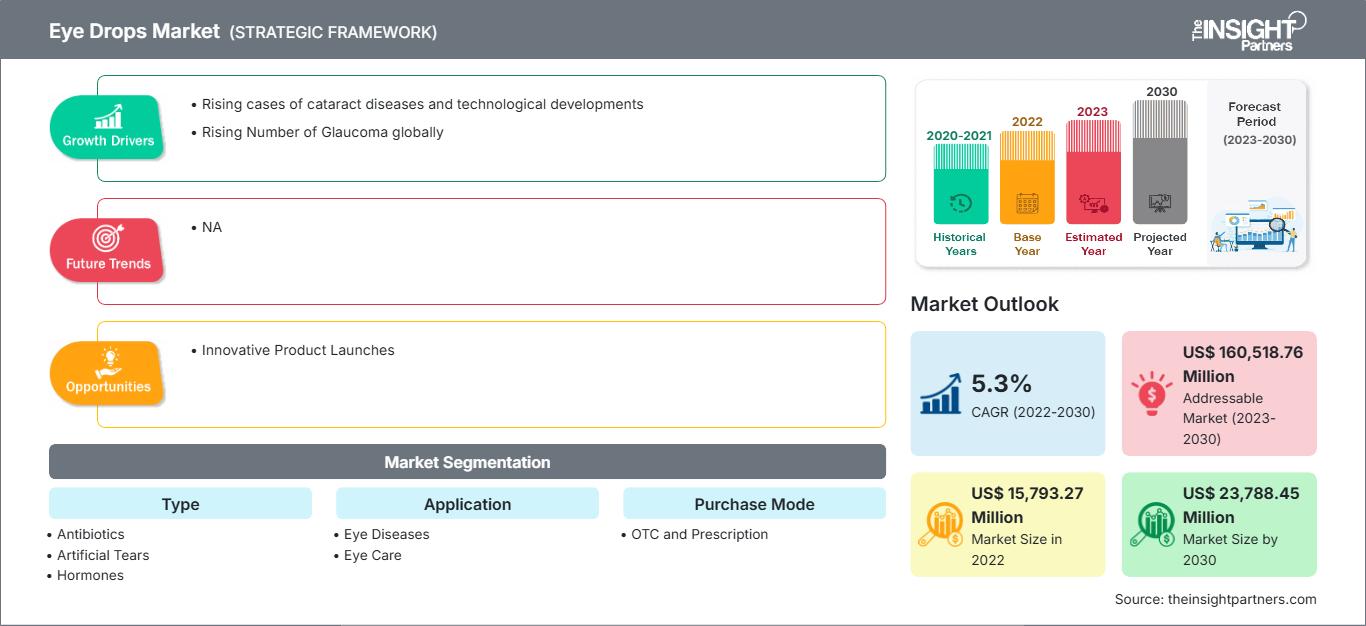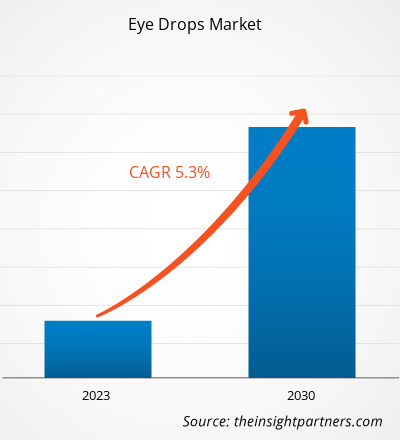Eye Drops Market Outlook and Strategic Insights by 2030
Historic Data: 2020-2021 | Base Year: 2022 | Forecast Period: 2023-2030Eye Drops Market Size and Forecast (2020 - 2030), Global and Regional Share, Trend, and Growth Opportunity Analysis Report Coverage: By Type (Antibiotics, Artificial Tears, Hormones, and Others), Application [Eye Diseases (Dry Eye, Glaucoma, Cataract, and Others), Eye Care, and Others], Purchase Mode (OTC and Prescription), and Geography
- Report Date : Aug 2023
- Report Code : TIPRE00011308
- Category : Life Sciences
- Status : Published
- Available Report Formats :


- No. of Pages : 188
The eye drops market size is projected to reach US$ 23,788.45 million by 2030 from US$ 15,793.27 million in 2022. The market is expected to register a CAGR of 5.3% during 2022–2030. Rising cases of cataract diseases and technological developments are likely to remain key trends in the market.
Eye drops Market Analysis
According to the Lancet, it has been estimated that the prevalence of cataract increases with age which is from 3·9% at age 55–64 years to 92·6% at age 80 years and above. Pediatric cataracts are one of the most common causes of treatable childhood blindness, with an estimated prevalence ranging from one to six per 10000 live births.. Such a factor is expected to drive the eye drops market during the forecast period 2022 – 2030.
Eye Drops Market Overview
According to the Glaucoma Research Foundation, there were about 80 million people worldwide in 2020 with glaucoma and the numbers are expected to rise in future years reaching 111 million by 2040. The most common treatment for the same is prescription eye drops. There are seven eye drops type to treat glaucoma. Such a factor has resulted in the growth of eye drops market.
Customize This Report To Suit Your Requirement
You will get customization on any report - free of charge - including parts of this report, or country-level analysis, Excel Data pack, as well as avail great offers and discounts for start-ups & universities
Eye Drops Market: Strategic Insights

-
Get Top Key Market Trends of this report.This FREE sample will include data analysis, ranging from market trends to estimates and forecasts.
Eye Drops Market Drivers and Opportunities
Rising Number of Vision Impaired Persons in India to Favor Market
According to the Financial Express, approximately 4.95 million blind persons and 70 million vision-impaired persons are present in India. The economic burden of this is significantly high with an estimated net loss of gross national income due to blindness coming to INR 845 billion.
In general, eye diseases and vision disorders are extremely common. According to the World Health Organization (WHO), it has been estimated that over 2.2 billion people have some form of vision impairment or blindness.
Thus, the major factors leading to the eye drops market growth are the growing number of blind person cases in India .
Innovative Product Launches
In the recent past, it has been observed that market participants are launching new products that helps physicians to monitor the patient’s continuously. For instance, in 2020, the FDA approved MiSight 1 day (CooperVision) lenses making them the daily disposable soft contact lenses labeled for slowing the progression of myopia. Clinical studies found that MiSight 1 day lenses provided a 59% reduction in myopia progression in comparison with a single-vision 1-day lens, as measured by spherical equivalent, and a 52% reduction in mean axial elongation.
Eye Drops Market Report Segmentation Analysis
Key segments that contributed to the derivation of the eye drops market analysis are type and purchase mode.
- Based on type, the eye drops market is segmented into antibiotics, artificial tears, hormones, and others. The antibiotics segment held the largest market share in 2022.
- Based on purchase mode, the eye drops market is divided into OTC and prescription. The prescription segment is expected to witness a higher CAGR during the forecast period. These include Cyclosporine (Restasis) and Lifitegrast (Xiidra).
Eye drops Market Share Analysis by Geography
The geographic scope of the eye drops market report is mainly divided into five regions: North America, Asia Pacific, Europe, Middle East & Africa, and South & Central America.
North America has dominated the eye drops market. Increasing cases of glaucoma and rise in myopia cases in the United States has led the growth of regional market. According to the Bright Focus, over three million Americans are living with glaucoma, 2.7 million of whom are aged 40 and older and are affected by its most common form, open-angle glaucoma. Asia Pacific region is anticipated to grow with the highest CAGR in the coming years.
Eye Drops Market Regional Insights
The regional trends and factors influencing the Eye Drops Market throughout the forecast period have been thoroughly explained by the analysts at The Insight Partners. This section also discusses Eye Drops Market segments and geography across North America, Europe, Asia Pacific, Middle East and Africa, and South and Central America.
Eye Drops Market Report Scope
| Report Attribute | Details |
|---|---|
| Market size in 2022 | US$ 15,793.27 Million |
| Market Size by 2030 | US$ 23,788.45 Million |
| Global CAGR (2022 - 2030) | 5.3% |
| Historical Data | 2020-2021 |
| Forecast period | 2023-2030 |
| Segments Covered |
By Type
|
| Regions and Countries Covered |
North America
|
| Market leaders and key company profiles |
|
Eye Drops Market Players Density: Understanding Its Impact on Business Dynamics
The Eye Drops Market is growing rapidly, driven by increasing end-user demand due to factors such as evolving consumer preferences, technological advancements, and greater awareness of the product's benefits. As demand rises, businesses are expanding their offerings, innovating to meet consumer needs, and capitalizing on emerging trends, which further fuels market growth.

- Get the Eye Drops Market top key players overview
Eye Drops Market News and Recent Developments
The eye drops market is evaluated by gathering qualitative and quantitative data post primary and secondary research, which includes important corporate publications, association data, and databases. A few of the developments in the eye drops market are listed below:
- Lupin announced the launch of bromfenac ophthalmic solution, 0.07%, in the United States, one of the leading healthcare companies in the United States market. (Source: CNBC TV18, Newsroom, January 2024)
- Bausch + Lomb launched INFUSE Multifocal silicone hydrogel (SiHy) contact lenses for daily use for presbyopia management designed to help maintain ocular surface homeostasis to assist in minimizing contact lens dryness. (Source: Glance By Eyes On Eyecare, June 2023)
Eye Drops Market Report Coverage and Deliverables
The “Eye Drops Market Size and Forecast (2020–2030)” report provides a detailed analysis of the market covering below areas:
- Eye drops market size and forecast at global, regional, and country levels for all the key market segments covered under the scope
- Eye drops market trends as well as market dynamics such as drivers, restraints, and key opportunities
- Detailed PEST/Porter’s Five Forces and SWOT analysis
- Eye drops market analysis covering key market trends, global and regional framework, major players, regulations, and recent market developments
- Industry landscape and competition analysis covering market concentration, heat map analysis, prominent players, and recent developments for the Eye drops market
- Detailed company profiles
Frequently Asked Questions
Which region dominated the eye drops market in 2022?
What are the driving factors impacting the eye drops market?
What are the future trends of the eye drops market?
Which are the leading players operating in the eye drops market?
What would be the estimated value of the eye drops market by 2030?
What is the expected CAGR of the eye drops market?
Mrinal is a seasoned research analyst with over 8 years of experience in Life Sciences Market Intelligence and Consulting. With a strategic mindset and unwavering commitment to excellence, she has built deep expertise in pharmaceutical forecasting, market opportunity assessment, and developing industry benchmarks. Her work is anchored in delivering actionable insights that empower clients to make informed strategic decisions.
Mrinal’s core strength lies in translating complex quantitative datasets into meaningful business intelligence. Her analytical acumen is instrumental in shaping go-to-market (GTM) strategies and uncovering growth opportunities across the pharmaceutical and medical device sectors. As a trusted consultant, she consistently focuses on streamlining workflow processes and establishing best practices, thereby driving innovation and operational efficiency for her clients.
- Historical Analysis (2 Years), Base Year, Forecast (7 Years) with CAGR
- PEST and SWOT Analysis
- Market Size Value / Volume - Global, Regional, Country
- Industry and Competitive Landscape
- Excel Dataset
Recent Reports
Related Reports
Testimonials
The Insight Partners' SCADA System Market report is comprehensive, with valuable insights on current trends and future forecasts. The team was highly professional, responsive, and supportive throughout. We are very satisfied and highly recommend their services.
RAN KEDEM Partner, Reali Technologies LTDsI requested a report on a very specific software market and the team produced the report in a few days. The information was very relevant and well presented. I then requested some changes and additions to the report. The team was again very responsive and I got the final report in less than a week.
JEAN-HERVE JENN Chairman, Future AnalyticaWe worked with The Insight Partners for an important market study and forecast. They gave us clear insights into opportunities and risks, which helped shape our plans. Their research was easy to use and based on solid data. It helped us make smart, confident decisions. We highly recommend them.
PIYUSH NAGPAL Sr. Vice President, High Beam GlobalThe Insight Partners delivered insightful, well-structured market research with strong domain expertise. Their team was professional and responsive throughout. The user-friendly website made accessing industry reports seamless. We highly recommend them for reliable, high-quality research services
YUKIHIKO ADACHI CEO, Deep Blue, LLC.This is the first time I have purchased a market report from The Insight Partners.While I was unsure at first, I visited their web site and felt more comfortable to take the risk and purchase a market report.I am completely satisfied with the quality of the report and customer service. I had several questions and comments with the initial report, but after a couple of dialogs over email with their analyst I believe I have a report that I can use as input to our strategic planning process.Thank you so much for taking the extra time and making this a positive experience.I will definitely recommend your service to others and you will be my first call when we need further market data.
JOHN SUZUKI President and Chief Executive Officer, Board Director, BK TechnologiesI wish to appreciate your support and the professionalism you displayed in the course of attending to my request for information regarding to infectious disease IVD market in Nigeria. I appreciate your patience, your guidance, and the fact that you were willing to offer a discount, which eventually made it possible for us to close a deal. I look forward to engaging The Insight Partners in the future, all thanks to the impression you have created in me as a result of this first encounter.
DR CHIJIOKE ONYIA MANAGING DIRECTOR, PineCrest Healthcare Ltd.Reason to Buy
- Informed Decision-Making
- Understanding Market Dynamics
- Competitive Analysis
- Identifying Emerging Markets
- Customer Insights
- Market Forecasts
- Risk Mitigation
- Boosting Operational Efficiency
- Strategic Planning
- Investment Justification
- Tracking Industry Innovations
- Aligning with Regulatory Trends




















 Get Free Sample For
Get Free Sample For